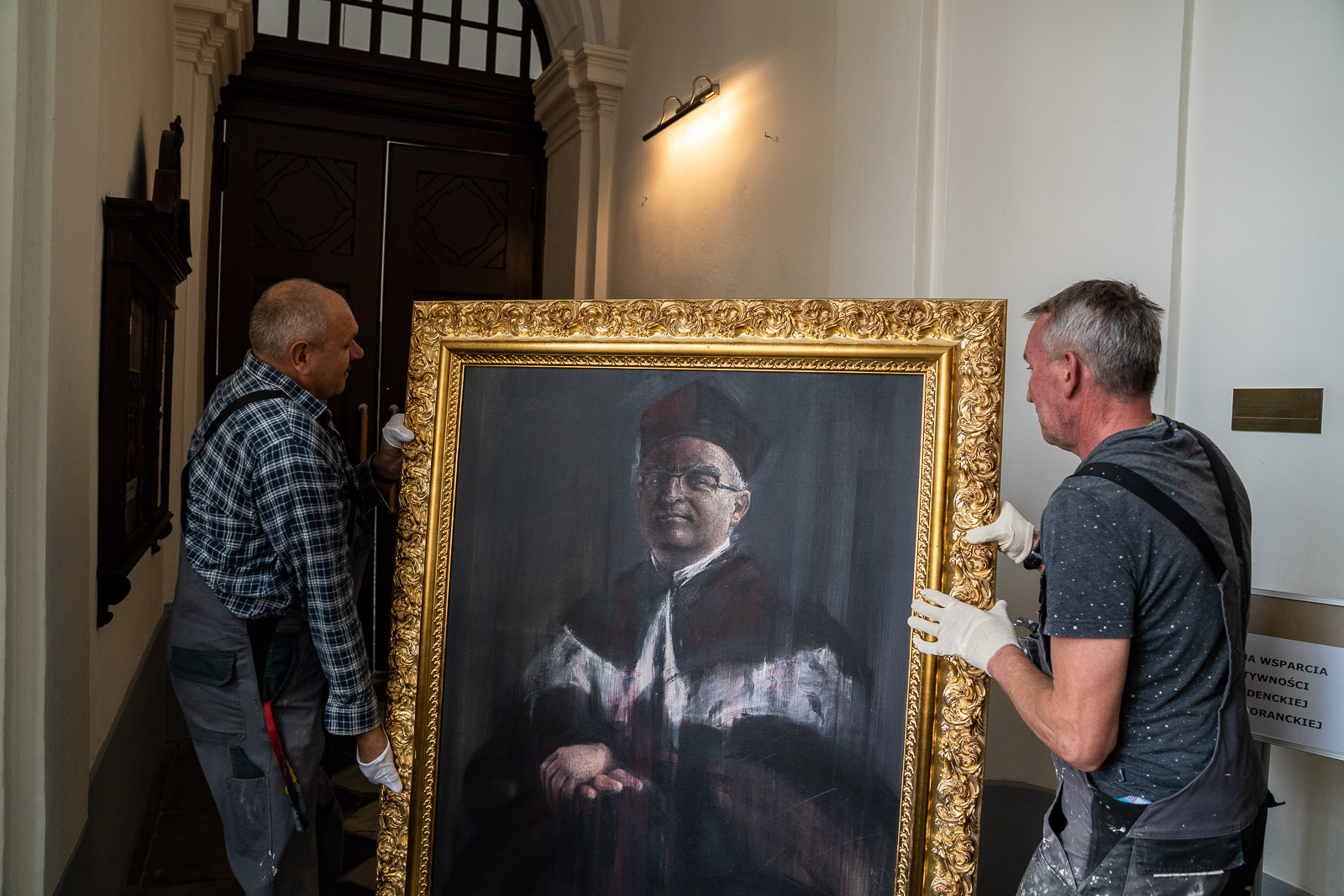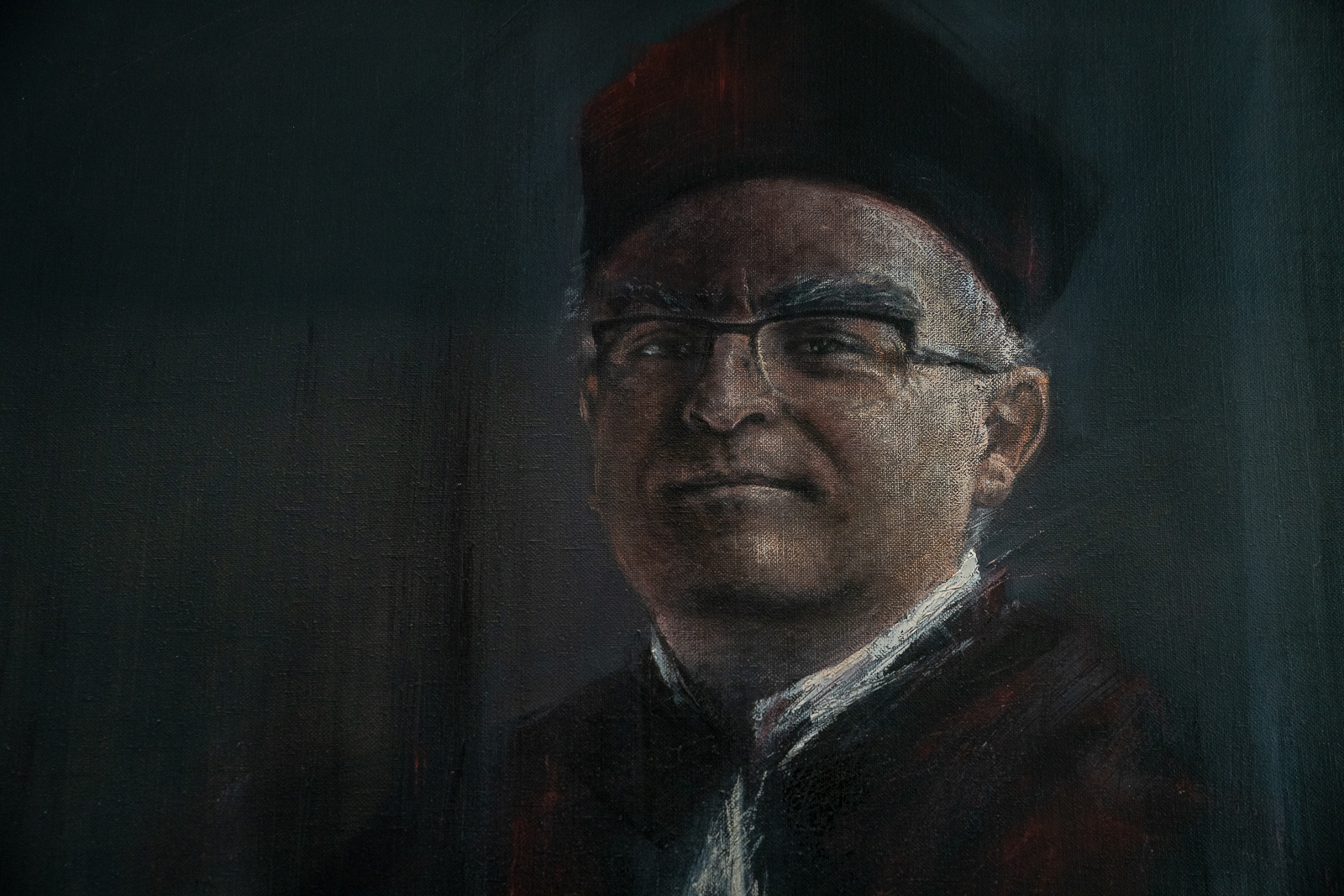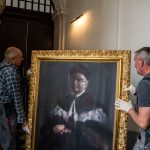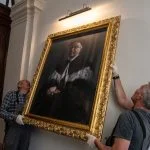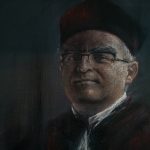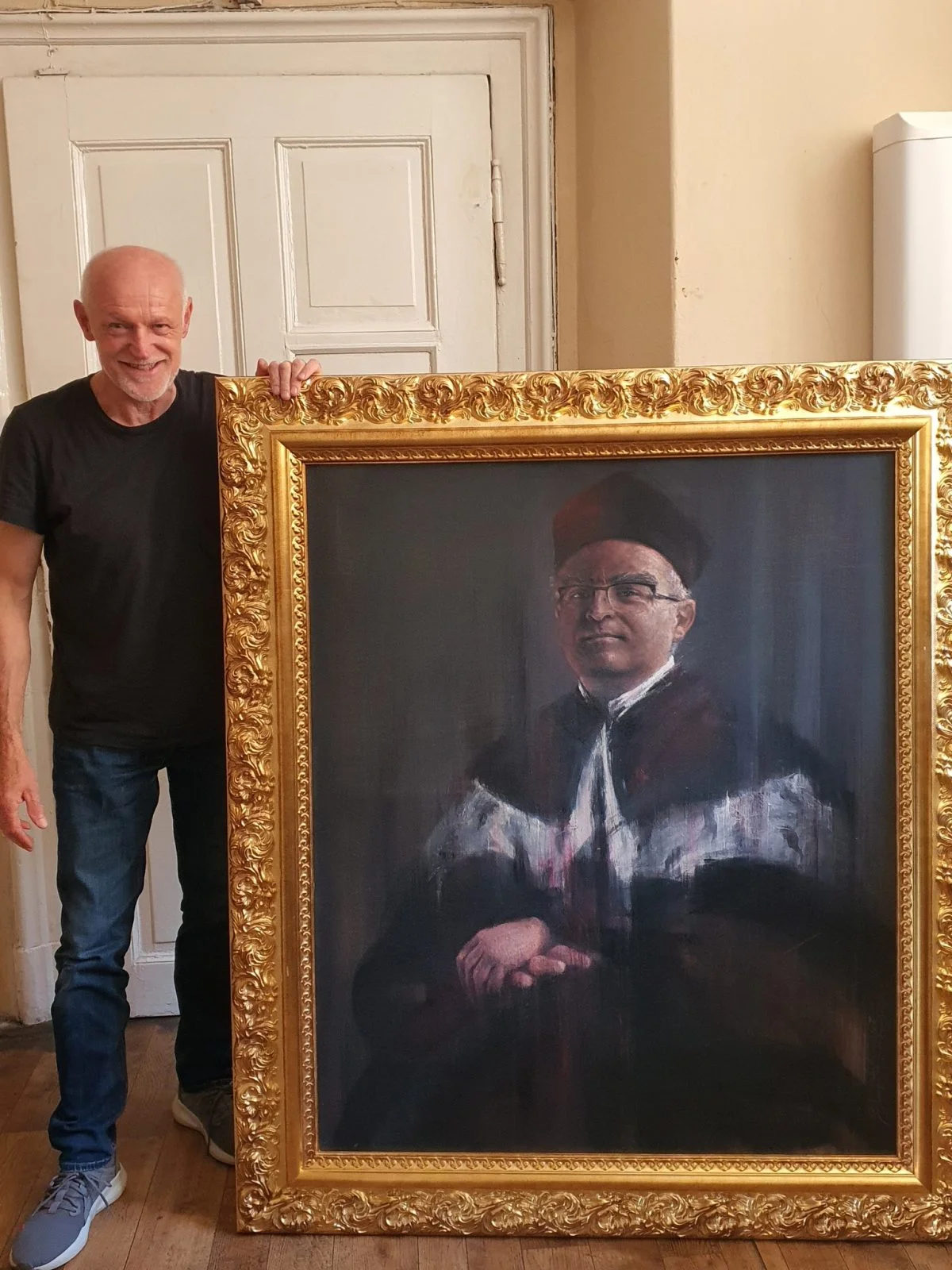
Portrait of rector Przemysław Wiszewski in the rector’s corridor
The portrait of the 2020-2022 incumbent rector, Professor Przemysław Wiszewski, hung in the corridor leading from the Aula Leopoldina to the rector’s office on 28 August 2023. It is the twenty-first painting in the gallery of rector portraits in the corridor on the second floor of the main building of the University of Wrocław, and was painted by artist Wiesław Smętek.
It is a tradition of our university that after the end of a rector’s term, the UWr Senate approves, at the request of the incumbent rector, the decision to commission the painting of a portrait of the rector of the previous term. It is usually the portrayed former university rector himself who chooses the painter and with him arranges the details of the portrait, but usually in the gallery all the rectors look very dignified: they sit in the rector’s chair clad in red togas and white ermine, with the attributes of rectorial power – chain, scepter and ring. The Wrocław gallery does not differ in standards from similar ones found at all historically recognized universities in the world, but it contains two paintings that differ from the rest. The first is a portrait of rector prof. Leszek Pacholski, who was rector from 2005 to 2008. Professor Pacholski in the portrait by Leszek Żegalski, a student of Jerzy Duda-Gracz, who is professor Pacholski’s favorite painter, is dressed in an open short-sleeved shirt and jeans, while his rector’s toga is carelessly thrown over his shoulder. This is probably a rarity in realtor galleries worldwide.
The second painting that stands out from the rest is a portrait of prof. Wiszewski – the work of Wiesław Smętek, a Polish painter and graphic artist, prof. Krzysztof Ruchniewicz wrote: “Wiesław Smętek has been living and creating in Germany for years. He collaborates with Polish magazines, including Polish-German Magazine DIALOG. He also designs book covers. The number of graphics he has made for the covers of leading German newspapers and magazines goes into the hundreds. Each attracts attention with an idea and perfect execution. There is no foreign topic for him, including taboo subjects. He is able to deal with everyone, usually proposing several solutions. He designs with great detachment and humor. A frequent motif he uses are historical themes, including from the Polish past and Polish-German relations. In his own way, he “reworks” the works of Polish and foreign brush masters “*.
Mr. rector prof. Wiszewski told us some interesting facts about the portrait:
It is the former rector who chooses the painter who creates the portrait. Why did you specifically choose Mr. Wiesław Smętek as the author of your rector portrait? How did the cooperation work? Perhaps some interesting anecdote related to the collaboration?
I got to know Mr. Wiesław through publishing cooperation. I had previously heard about his graphic work for major German weeklies (Der Spiegel, Stern, Die Zeit). I was struck by their sense of humor, vast and brilliant imagination matching the messages growing out of our culture with the content suggested by the ordering parties. Not insignificant is the precision with which the Artist executes his works – both graphic and painting. Well, and we have one thing in common without a doubt – love for modern Dutch painting. In the end, it prevailed to work with Mr. Smętek on the cover of one of his books (a synthesis of German-Polish relations published this year). Because in addition to interesting ideas, Mr. Wiesław turned out to be a very flexible creator, ready to discuss projects and make changes to them. We started with designs close to his heart, but after changes made at the request of myself as the author and prof. Krzysztof Ruchniewicz as the publisher – we got a completely different design. It cost the Creator many hours of work and many compromises on his part. This attitude of an established artist, for whom this was one of many commissions, commands my utmost respect. It was a sheer pleasure to work with him, and she ultimately made the decision.
How long did the work on the portrait take? Is what we see the original idea, or were there any changes to the concept?
The work took about six months. We began by exchanging comments about our favorite portraits. Then I conveyed what I would like to see in the portrait, and Mr. Wiesław said that it was probably better not to… We argued a bit, but in the end I decided that he knew better. We then chose the style in which the portrait was to be made. And since we both like the aforementioned Dutch painting, it became the starting point for the work. Later we met and talked about various topics. This was probably the most important part of working on the portrait, after all, the question hanging over us was – will there be chemistry between the Creator and the material? It seems to me that it was and is. As a result, Mr. Wiesław had a free hand to create a portrait within the established framework. In addition to the sketches, I received an insight into the penultimate version. It was the subject of insightful comments by my Wife, the most important instance. After the associated necessary corrections, the portrait was ready.
As we look at the entire gallery of paintings in the rector’s corridor, the painting of Rector Pacholski and yours stand out from the rest. It is a tradition that rectors are portrayed wearing togas and insignia. In the portrait, Rector Pacholski has his toga slung over his shoulder and is wearing jeans and a shirt. Although the rector has a toga in his portrait, he does not have the traditional rector’s insignia – chain, scepter, ring. Why? Where did such an idea come from?
This is a bit of a product of Mr. Wiesław’s concept and mine. The creator wanted the portrait not to break too much from traditional convention. But at the same time, to emphasize the interruption, the lack of completion, the break in continuity caused by the expiration of the term. Therefore, not all the details are on it, part of the background is unfinished. For me, it was important that, while preserving tradition, it was important to break the rigidity, to bind the rector with chains of traditions and habits that have always been there and should not be changed. I believed, and continue to believe, that bad habits should be changed, and that rational novelty, aimed at moving toward quality, is worth much more than patina-covered silver-plated chains and faded ermine. But tradition emphasizes continuity, stability and security for the environment. This combination of tradition and courage in presenting one’s views without hiding behind symbols has always been important to me. Well, finally, calmness, lack of infliction and negative emotions were to be the finish of this picture.
How does Mr. Rector like the end result? How was the portrait received by your family and friends? Did they like it?
I am very satisfied with the end result. As I mentioned, in my vision it had other elements that would probably be described as controversial and defiant. So maybe it’s better that they are gone. The family has different opinions. They have always supported me during the uneasy months of this term, but they have also suffered a lot because of it. Thus, it is difficult to take an objective view of an image that also recalls very unpleasant events. For me, however, it is exactly as it should be – open to the viewer, slightly ironic, but always heartfelt and simple.
Interview: Agata Mitek
Photos: Paweł Piotrowski
*prof. Krzysztof Ruchniewicz: „Z humorem, dystansem, ogromną precyzją. Wiesław Smętek”, Porta Polonica.
